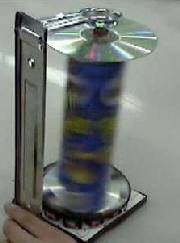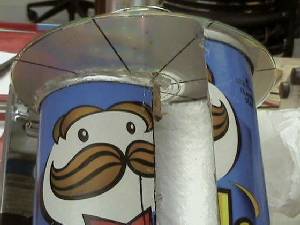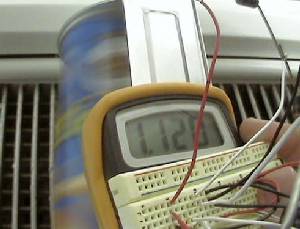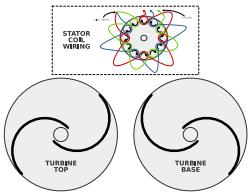Although vertical axis wind turbines are less efficient than windmill type wind turbines they are typically much easier to build by the amateur DIY enthusiast. If you are interested in making your first wind turbine then the following plans should be of interest to you.
They were put together by Mike Edwards as part of his final project at Parsons The New School for Design.
The Pringle Tube Wind Turbine

The mini wind turbine described in this article (and pictured above) was designed to generate act as a low-voltage power supply then spun indoors by the air blown from air-conditioning ducts, dryer vents etc. With basic weatherproofing it could also be used outdoors to act as a battery charger or to light some LEDs.
Making a Pringles Tube Wind Turbine

The turbine blades (pictured above) are made from a used Pringles can and a couple of CDs. Rather than using an expensive and often difficult to find bearing, a standard paper towel holder is used. The alternator was built using 28 AWG enamelled magnet wire however much thinner 36 AWG * wire is recommended since it enables far more turns to be used in the coils and therefore a higher (more useful) voltage to be generated.
* Click here to view our guide to wire sizing, AWG to mm diameter conversions and so on, and here to find out about Voltage Doublers and Multipliers – useful for increasing the voltage output from an AC alternator.
Basic soldering skills are necessary for wiring everything up, and a hot glue gun is used to hold everything else together.

In order to hold the coils in shape sewing machine aluminium bobbins are used. (Steel bobbins are far more common – and completely unsuitable for this project.) Aluminium bobbins can be found in sewing machine shops and online (click here: aluminium bobbins. The magnets used are round super-strong neodymium magnets.
Plans for wiring the coils together and constructing a three-phase AC to DC bridge rectifier from diodes are provided.
The Completed Wind Turbine

The finished wind turbine generated 5.8 Volts with a current of over 120mA – certainly enough to power a string of LEDs or to charge a couple of AA/AAA batteries. Using thinner (e.g. 36 AWG) magnet wire with more turns in each coil would have increased the output voltage sufficiently to make a useful battery trickle charger. Adding another disk of 8 magnets to spin beneath the coils in addition to that already spinning over the coils would immediately double the current generated by this wind turbine.
View Full Plans for the Pringle Tube VAWT
For full details on making your own Pringles Tube Wind Turbine from the Instructables website, click here: Pringles Wind Turbine (Pleech) – Version One.

Excellent templates to help you position the coils and magnets are also available online in PDF form in the following two files: Page 1, and Page 2.